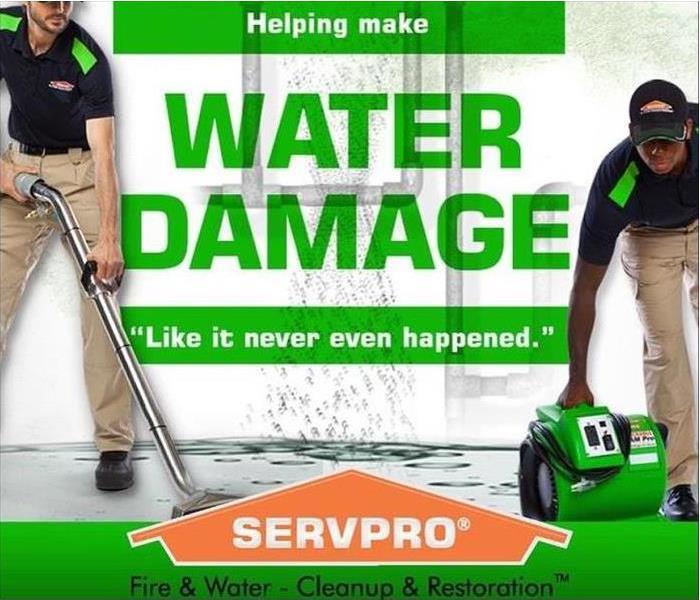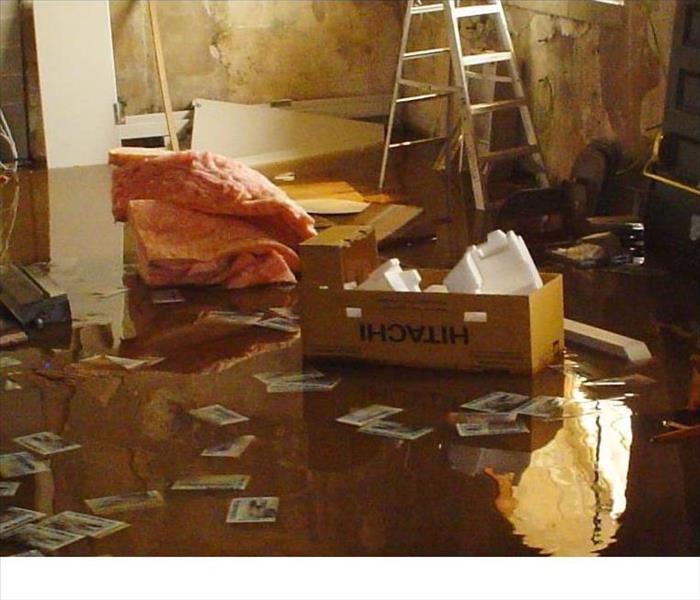Archived Water Damage Blog Posts
How to Prevent Water Damage
10/16/2023 (Permalink)
We here at SERVPRO love helping you clean up the aftermath of a flooded basement, but we also want to offer some insight on how to prevent the issue.
Here’s how to prevent water damage using these easy strategies that will give you peace of mind the next time heavy storms hit.
1. Making sure your drainage system is working properly:
-Clean your gutters
-Aim the downspout 6-12' inches from your foundation
2. Check your sump pump
-Test your sump pump once a year
-During storm season test more frequently
3. Fix water leaks
-Repair any leaks (Foundation, Pipes, Windows, etc.)
-Inspect your roof for any needed repairs
-Check for spots that are darker under your pipes
Water damage weakens your home’s foundation to the very core that holds your house together, eventually causing serious structural damage. Damp wood invites termites and carpenter ants; plus, it causes mold and mildew.
Winter Water Advice For Inclement Conditions
12/8/2022 (Permalink)
When it comes to preventing pipes from freezing in the winter, prevention, rather than treatment, is priority number one. Frozen pipes have the potential to leave you without access to running water during the most extreme winter weather bouts. These steps can help you preserve not only your pipes but your budget and mental health at the same time.
Before cold weather sets in, it's good to check your home's sprinkler or irrigation system and identify its location. Check your home for areas in which pipes located there are more likely to experience freezing. These include crawl spaces, basements, garages, exterior walls, or pipes near large windows. Strengthening your home's defenses by providing additional insulation for the inside of your house is crucial in fighting frozen pipes.
When the temperature outside does begin to freeze, it's a great idea to open cabinets and doors near pipes in order to help warm air continuously circulate throughout the nearby area. In the case of your pipes actually freezing, you will need to shut off the main water valve immediately. Use warm air to thaw out your pipes. Items such as a hair dryer, or space heater are great sources of heat. Never use an open flame, and never leave a space heater operating unattended. We hope this advice can help solve, or more importantly prevent any winter water emergencies.
If you ever find yourself in a winter water damage emergency, give SERVPRO of Ames a call. We are available 24/7 for immediate service in central Iowa, and we will arrive at a moment's notice. Our expert Emergency Response Crew is prepared to fully treat any size disaster, for both residential and commercial property owners. Call SERVPRO of Ames anytime at 515-233-4544 and we would love to help treat and remediate your water damage circumstances.
Steps to take if your bathroom floods
5/5/2022 (Permalink)
Here’s what to do as soon as you notice the flood:
1. Quickly identify where the leak is before you shut off the water
Determine the exact source of the flood water. Then if it’s a single fixture like a toilet overflowing, shut it off at the isolation valve. To shut off the mains water supply you must know where your stop tap is (It can be under the kitchen sink, under your cold water tank in the attic or even outside. If you’re a new homeowner, read our article on different types of home water systems, so you know where to find yours – different types of home water systems.
You can try and fix the leak if you can, but we would recommend calling in a professional plumber for most repairs.
2. Shut off electricity
Go to your circuit breaker panel to shut off your lighting and sockets circuits, to eliminate the risk of electrocution via your bathroom light or shaver socket. You don’t want to enter a water-soaked environment with outlets and light fixtures still on.
Your fuse box or consumer unit is likely to be under the stairs in a house, or close to the front door in a flat.
3. Remove standing water
Use anything you can – a mop, old towels, newspaper – to absorb the water and get it into buckets or down a drain. If you have a wet/dry vacuum cleaner, use that. If you have severe flooding, you may need to call a water damage clean-up service.
4. Save your possessions
Clear your bathroom cabinets and any other storage in contact with the wet floor. Check these areas for damage, and work out what kind of clean-up they need.
for more info visit homeserve.com
Simplify the Restoration Process
5/5/2022 (Permalink)
The SERVPRO of Ames team can simplify the restoration process by handling both the initial damage mitigation and rebuilding the affected areas. Having one qualified company for the entire process can save time.
SERVPRO of Ames can provide this continuity by supervising a full range of restoration services that will bring a building back to full functionality.
- Board Up
- Carpet Repair and Installation
- Document Drying
- Dry Cleaning
- Drywall Installation
- Drywall Removal
- Electrical
- Electronics Restoration
- Fine Art Restoration
- Furniture Restoration
- General Contracting
- Hardwood Floor Repair
- HVAC Services
- Pack Out
- Painting
- Portable Power
- Roof Tarp
- Temporary Warehouse Space
- Tile Floor Repair
SERVPRO of Ames is here to help with all types of disasters. If it happens to your home or business we are here to help!
Call today with any questions! (515) 233-4544
Tips For Water Emergencies Before Help Arrives
2/26/2022 (Permalink)
What You Can Do Until Help Arrives
After any water damage situation, your primary focus should be safety:
- Is it safe to stay in the house?
- Electrical and "slip and fall" hazards are some of the most prevalent concerns.
- Only do activities that are safe for you to perform.
- Wet materials can be VERY heavy. Be careful!
What To Do After Flooding
- Remove excess water by mopping and blotting.
- Wipe excess water from wood furniture after removal of lamps and tabletop items.
- Remove and prop wet upholstery and cushions.
- Place aluminum foil or wood blocks between furniture legs and wet carpeting.
- Turn air conditioning on for maximum drying in summer.
- Remove colored rugs from wet carpeting.
- Remove art objects to a safe, dry place.
- Gather loose items from floors.
What NOT To Do After Flooding
- Don't leave wet fabrics in place. Hang furs and leather goods.
- Don't leave books, magazines or other colored items on wet carpet or floors.
- Don't use your household vacuum to remove water.
- Don't use television or other household appliances.
- Don't turn on ceiling fixtures if ceiling is wet, and keep out of rooms where ceilings are sagging.
If you ever need help involving a water damage emergency, or have any questions related to water issues, contact SERVPRO of Ames by phone anytime at (515) 233-4544 or you can find us on Facebook at SERVPRO of Ames.
Tips to Trick The Cold: Winterizing Your Home
1/12/2022 (Permalink)
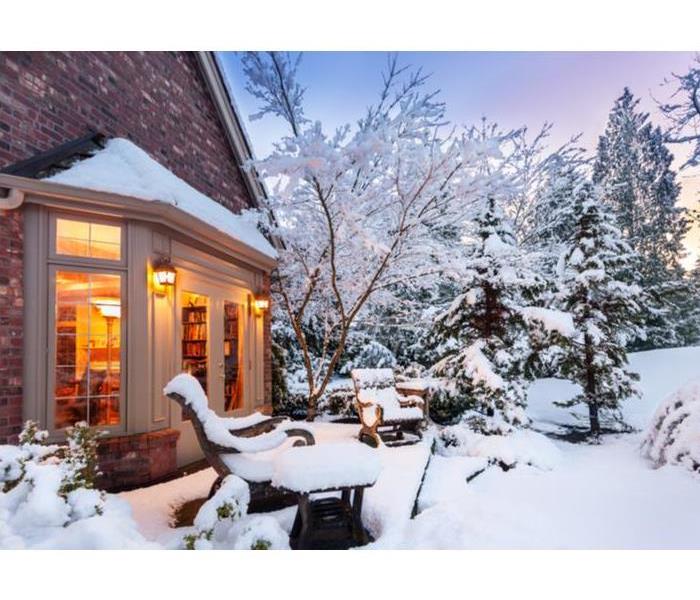 Winterize your home before cold weather arrives, so you can relax after!
Winterize your home before cold weather arrives, so you can relax after!
Winter is here to stay, with frigid weather Iowans are more traditionally used to arriving just in time for the new year. When cold weather hits, our instinct is to begin thinking of how to protect ourselves from the lower degrees. We should also, however, get in a habit of paying the same cold-weather attention to our residences or commercial businesses. Winterizing your home not only saves you money on energy bills, but it also helps ensure a warmer, less stressful winter when indoors.
Before you suffer a water damage event brought on by cold temperatures, you should check your home or commercial property for areas that may need additional insulation, heating, or other attention that will prevent freezing weather from penetrating your property and potentially damaging water pipes in the process. Depending upon the size of your home or commercial property, this type of scenario can result in thousands of dollars in damage and may require many weeks of construction to restore. At SERVPRO of Marshalltown, it is our goal to stop a potential situation from occurring beforehand through preventable measures. Here are some tips for winterizing your home in central Iowa!
- Seal your home
Give your home a quick run-through, checking for visible, as well as hidden drafts. One way of doing this is by holding a lit candle near the following areas:
- Windows
- Doors
- Vents and fans
- Plumbing areas
- Air conditioners
- Mail chutes
- Electrical and gas lines
If the candle flickers, you probably have a draft.
Seal any holes and reinforce existing points of entry with weather stripping. Everything you need for this should be able to get found in any local hardware store.
- Check heat, turn off external faucets, protect pipes
Draining your sprinkler system and shutting off all external hoses is the best way to help prevent water pipes from freezing. Check your heating system periodically to ensure that it’s working properly in a safe manner, before cranking it to full blast during the coldest stretches of weather. The most important phase of winterizing your home or commercial property involves potentially frozen pipes, and how to avoid them.
- Keep your heat on—even when you’re not home. You don’t need to turn the thermostat up when you’re out, but you should keep it at a moderately warm temperature, so your home’s pipes don’t freeze and burst.
- Allow your faucets to drip during severe cold snaps so that the water flows through your cold pipes. Allowing the water to stay stagnant puts it at greater risk of freezing.
- Wrap any exposed piping to prevent freezing. You can find foam rubber or fiberglass sleeves for pipes and outdoor hose bibs at most hardware stores.
- Review all locations inside your property where water pipes are running. In particular, check pipes close to exterior walls, in basements, in attics, adjacent to unheated areas (i.e. garages) or pipes that are just in colder areas of your property. If necessary, place an exterior thermometer in the space to see if the temperature is warmer than the outside air.
If these areas are cold than it may be a good idea to insulate the pipes, or the surrounding area, or add a space or pipe heater. If you have any questions, contact us 24/7 by phone at (515) 233-4544 or on Facebook at SERVPRO of Marshalltown.
Frozen Pipes? This Might Help
12/29/2021 (Permalink)
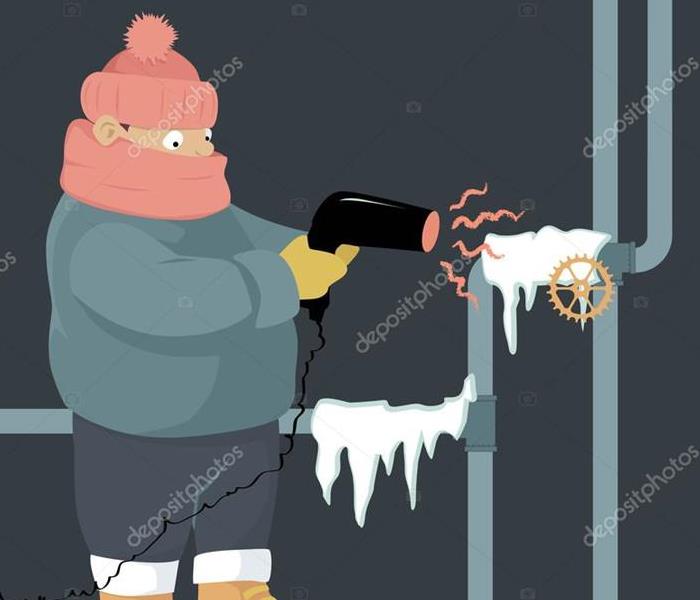 Frozen pipes this winter? Reach out to SERVPRO of Marshalltown today!
Frozen pipes this winter? Reach out to SERVPRO of Marshalltown today!
The Backstory
As the temperatures outside begin lowering themselves at a quickened rate, it seems like forever ago Iowans wished for a real, traditional winter, if not atleast a white Christmas. Sometimes frigid temps such as these create the perfect storm for cold-weather emergencies due to a multitude of unforeseen circumstances, often at the expense of home and business owners alike. At SERVPRO of Marshalltown, we understand the stress attached to winter emergencies such as pipes freezing, and wish to remediate the problem right away.
If a pipe within your home freezes, call us at (515) 233-4544. Our dedicated, knowledgeable crew will arrive onsite to begin the water damage remediation process. SERVPRO of Marshalltown is faster to any size disaster. After fixing the water damage and shutting all pipes off, the immediate area damaged will then be restored back to how it looked prior to the pipes freezing.
The Process
By working with plumbers, SERVPRO of Marshalltown is able to ensure a quick rebuild process to the affected area, while simultaneously carrying out water damage tests to further examine deeper, more hidden areas of destruction, namely water buildup within nearby walls. Although the damage assessment and restoration process may seem like a lot, SERVPRO of Marshalltown hopes to solve any disaster issue at its earliest, in order to keep our customers the happiest.
How To Prevent Frozen Pipes
While we can’t control the weather, there are things we can do to prevent pipes from freezing. To prevent pipes from freezing and causing major damage, follow these steps:
- Drain water from pipes that are likely to freeze. This includes your swimming pool and sprinkler water supply lines.
- Disconnect any hoses from the outside of your home, drain the hoses and store them in the garage. Make sure to close the indoor valves supplying these outdoor access points.
- Insulate the area around vents and light fixtures. This helps prevent heat from escaping into the attic.
- Seal any wall cracks. Be sure to pay careful attention to the areas around utility service lines.
- Open kitchen cabinets. This allows the warm air to circulate around the pipes.
- Keep the garage doors closed to protect water lines.
- Allow your faucets to drip cold water on the coldest days. The movement will make it harder for the water to freeze.
- Keep your thermostat at the same temperature day and night. Never let it fall below 55 degrees Fahrenheit when you leave your home.
- Ensure you have proper seals on all doors and windows.
- Place a 60-watt bulb in areas where you’re concerned about pipes freezing. Make sure there are no combustible materials near the bulb.
Got further questions? Give us a call at (515) 233-4544 or contact us on Facebook for service 24/7.
Faster to your Story County Water Damage Event
12/6/2021 (Permalink)
Flooding and water emergencies don’t wait for regular business hours and neither do we. SERVPRO of Ames provides emergency cleaning and restoration services 24 hours a day, 7 days a week—including all holidays.
Faster To Any Size Disaster
Flooding and water damage is very invasive. Water quickly spreads throughout your home and gets absorbed into floors, walls, furniture, and more. SERVPRO of Ames arrives quickly and starts the water extraction process almost immediately. This immediate response helps to minimize the damage and the cleaning and restoration costs.
Need Emergency Service? Call Us 24/7 – (515) 233-4544
Water Damage Timeline
Within Minutes
- Water quickly spreads throughout your property, saturating everything in its path.
- Water is absorbed into walls, floors, upholstery, and belongings.
- Furniture finishes may bleed, causing permanent staining on carpets.
- Photographs, books, and other paper goods start to swell and warp.
Hours 1 - 24:
- Drywall begins to swell and break down.
- Metal surfaces begin to tarnish.
- Furniture begins to swell and crack.
- Dyes and inks from cloth and paper goods spread and stain.
- A musty odor appears.
48 Hours to 1 Week:
- Mold and mildew may grow and spread.
- Doors, windows, and studs swell and warp.
- Metal begins to rust and corrode.
- Furniture warps and shows signs of mold.
- Paint begins to blister.
- Wood flooring swells and warps.
- Serious biohazard contamination is possible.
More Than 1 Week:
- Restoration time and cost increase dramatically; replacing contaminated materials and structural rebuilding may be extensive.
- Structural safety, mold growth, and biohazard contaminants pose serious risks to occupants.
About SERVPRO of Ames
SERVPRO of Ames specializes in the cleanup and restoration of residential and commercial property after a fire, smoke or water damage event. Our staff is highly trained in property damage restoration. From initial and ongoing training at SERVPRO’s corporate training facility to regular IICRC-industry certification, rest assured our staff is equipped with the knowledge to restore your property. Call us or send a message through Facebook 24 hours a day, 7 days a week.
Catch Leaking Pipes Before They Cause Damage
9/21/2020 (Permalink)
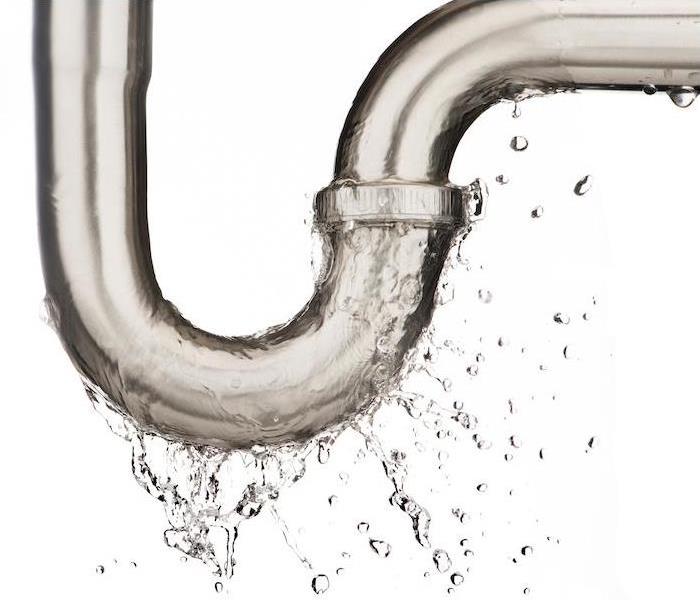 Be proactive about catching leaking water pipes and save yourself from possible water damage.
Be proactive about catching leaking water pipes and save yourself from possible water damage.
Ever wonder why your water bill is so high? Or have you noticed there’s dampness in the cabinet under your faucet?
We easily identify roof leaks when they splash on our heads, and it’s fairly simple to detect dripping appliances, but leaky pipes can be trickier to locate and correct. However, it’s essential to find them early, as slow leaks usually are not covered by insurance.
Plumbing repair sounds like a big project. But you can often fix a leaky pipe by yourself. This video shows you the basics. There are plenty of other do-it-yourself resources out there. A quick Google search gives a list of how-to videos by most major hardware businesses.
How to Spot Leaky Pipes Early
Check for signs of a leak on a regular basis. Traces of water can cue you in to leaky pipes. Look for damaged flooring or ceiling stains. Puddles are big clues, of course. You should also look for more subtle signs. Loose caulking might indicate a leak. Rust in your sink or toilet joints can also be signs of a leak. Loose tiles? Mold? A toilet that rocks back and forth? You guessed it—all can be caused by a leak.
Locate the source. Now that you know there’s likely a leak in the area, find where it’s coming from. You might need to open an access panel behind a tub or check under a sink. Look under countertops. You may want to fill a tub or sink and drain it, checking for dampness around each joint you can reach.
Evaluate if it’s a do-it-yourself job. Can you handily see and access the leaking pipe? If so, chances are you can make a repair. But if you can’t identify the source—or if you can see it but can’t get to it—it’s time to call a plumber. A certified, bonded plumber can make repairs that will save you money down the road.
When the Damage Is Done
If your leaking pipe has already caused damage, call SERVPRO. We’ve been cleaning up water damage for more than 50 years.
We’ll answer your call any time, around the clock. We combine national expertise with local know-how, so you know we’ll serve you right.
Dealing with water damage? Contact us at any hour for the rapid response we’re known for.
Hidden Spots for Household Water Damage
9/10/2020 (Permalink)
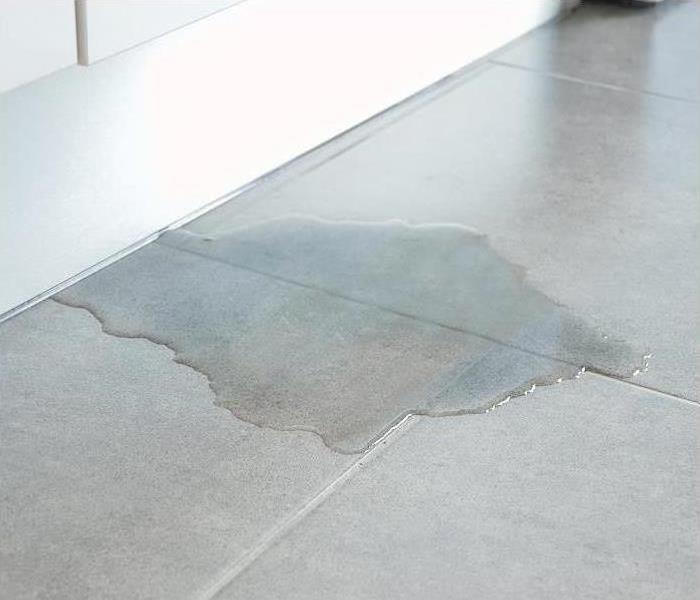 Check places in your home for hidden water damage on a regular basis.
Check places in your home for hidden water damage on a regular basis.
It’s common to associate water damage with flooding, but there are many other surprising reasons water damage can occur in a home—quite a few of which can occur in hidden locations.
Because water damage can become worse if left untreated, hidden water damage is especially insidious. Many homeowners’ policies do not provide coverage for water damage; when they do, a typical claim will be in the range of $7,000.
Knowing the surprising spots where water damage may be found and checking them regularly can go a long way in preventing complications.
Surprising Spots for Household Water Damage
- Inside cabinets: When sink pipes are inside cabinets, it’s easy for leaks to go unnoticed. Regularly check the piping to make sure you catch leaks before they cause damage.
- Near bathtub casings: The casing of the bathtub or shower is sealed with caulk around the edges, providing a barrier against leaks. However, if these have not been recaulked in a while, they can begin to falter.
- On structural elements: Drywall hides the structural elements of the home, but it can also hide water damage. Though ripping out drywall can be a chore, if there has been a busted pipe or a flood recently, it is wise to check behind it.
- Around seals in the roof: The vents of roofs are sealed to prevent water from entering, but the seals deteriorate over time. Check the roof at the start of spring and fall for signs of water.
- Within an HVAC unit: As the HVAC unit pulls moisture from the air, it typically drains it away. However, if there is an issue with any of the drain lines, this condensation can build up within the unit instead.
- Behind appliances: Appliances are rarely moved unless they are being replaced, but washing machines and dishwashers can also hide water leaks. Perform an inspection for any hidden damage every few months as a preventive measure.
- Around exterior faucets: Because outside faucets are connected within the walls of the house, leaks can easily hide. If the faucet is turned off and you still hear sounds of running water, there might be a hidden leak.
If you find water damage in your Boone or Story County home, give us a call right away, and we’ll be there quickly.
Protect Your Finished Basement With a Sump Pump
8/26/2020 (Permalink)
Your basement is finally nicely carpeted, stocked with food and drinks, filled with electronics, a home entertainment system and comfy furniture. But are you prepared if a strong summer storm threatens to flood your basement and ruin everything there? This is when it’s important to consider installing a sump pump.
Putting a sump pump at the lowest point of your house can help with flooding prevention. While not the prettiest sight, a sump pump can save you the thousands of dollars it can cost to clean up and restore a flooded basement. And if your basement floods once, chances are it will flood again.
A sump pump has two parts: a float switch and a mechanical pump. The entire mechanism is placed in the pit of the sump pump, which is at the lowest level of a house’s basement. When moisture leaks into the basement, the water level rises, eventually lifting the float switch high enough that it activates the pump. The water is then pumped out of the basement through a discharge pipe.
Sump pumps also have the ability to be connected to a dehumidifier, which will help pull the moisture out of the air and dump it directly into your sump pump. This helps prevent mold formation, which is another problem for basements. Most newer homes in the Midwest require a sump pump. If yours does not, we suggest doing your research and looking into it. They can save your home before a crisis hits.
If you do happen to experience flooding or water in your basement, call SERVPRO of Ames right away, and we’ll be there quickly to assess the damage and start restoring your basement back to its original condition, “Like it never even happened.” Call (515) 233-4544, anytime, day or night.
Ames Area Residents: Don’t Let Your Garden Hose Be the Culprit of Water Damage
5/7/2020 (Permalink)
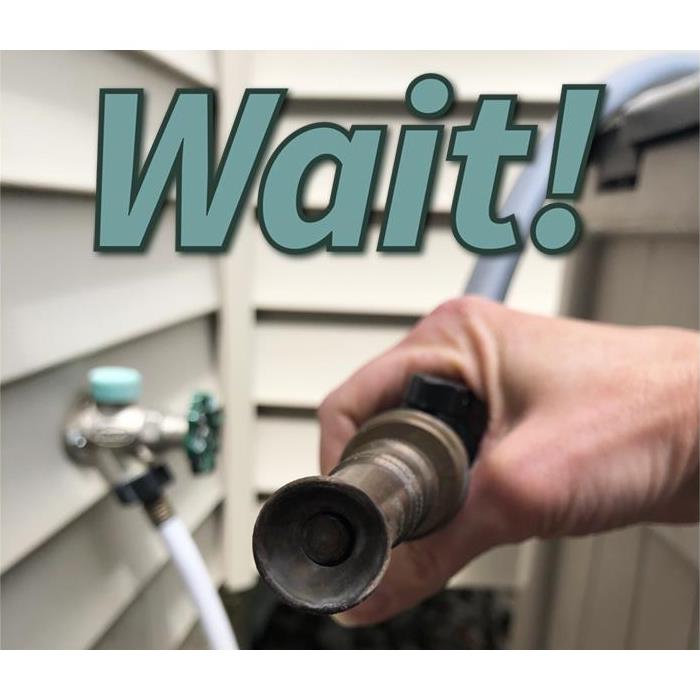 If you used your garden hose and didn't unhook it before temperatures dropped below freezing, make sure you check for a cracked water pipe.
If you used your garden hose and didn't unhook it before temperatures dropped below freezing, make sure you check for a cracked water pipe.
Remember that warm week in early April? People were thronging places like Ledges State Park near Boone and thoroughly enjoying the weather.
Have You Ever Done This?
We had one client in Ames whose son took advantage of the near 80-degree temps to hook up the hose and wash his car. Lots of people probably did.
Of course, Iowa temps in April are a crazy roller coaster, and about a week later they dropped below freezing, with a little bit of snow and ice to boot. The water left in the line from the hose still being hooked to the house expanded and cracked the copper water pipe that ran inside. And the homeowner had no idea. Guess what happened.
The Unsuspected Culprit
Once it warmed back up, they turned on the hose again without realizing water was running down into their basement. We see this a lot.
If it’s a big crack, it will cause immediately noticeable water damage. If it’s a small one, it causes a leak that can go unnoticed and result in mold formation. Either way, you can prevent it.
How To Prevent Water Damage From Your Garden Hose After a Freeze
If you used your hose during that early warm streak and haven’t turned it on again, and if the water pipe is exposed, you can simply go down to where the line comes into your basement, have someone turn the hose on full blast and monitor the pipe for any leaking.
If you have turned on your hose again after using it during the warm weather, you should go inspect the area around the pipe in your basement for any signs of water leaking or damage.
To prevent this in the future, make sure you winterize by unhooking all garden hoses well before temperatures drop below freezing in the fall and waiting to reattach until temperatures have stabilized in the spring. If you do use your hose in early spring, it’s always good to unhook it immediately afterward.
See any problems or have concern? Call us right away at 515-233-4544. Water can spread and be absorbed quickly, so you don’t want to wait.
SERVPRO of Ames Will Guide You to the Right Solution
SERVPRO of Ames is locally owned and close by, available 24 hours/7 days per week. Our highly trained and IICRC-certified staff is ready to come out and let you know what needs to be done, whether our services are needed or not, at no charge.
If you just need a plumber - we’ll tell you that. If you need help with water damage repair and/or mold remediation, you can trust SERVPRO as the No. 1 brand in the restoration industry.
We have superior equipment and tools to evaluate your damage and make all the repairs so it’s “Like it never even happened.”
Flooded basement in Ames
4/22/2020 (Permalink)
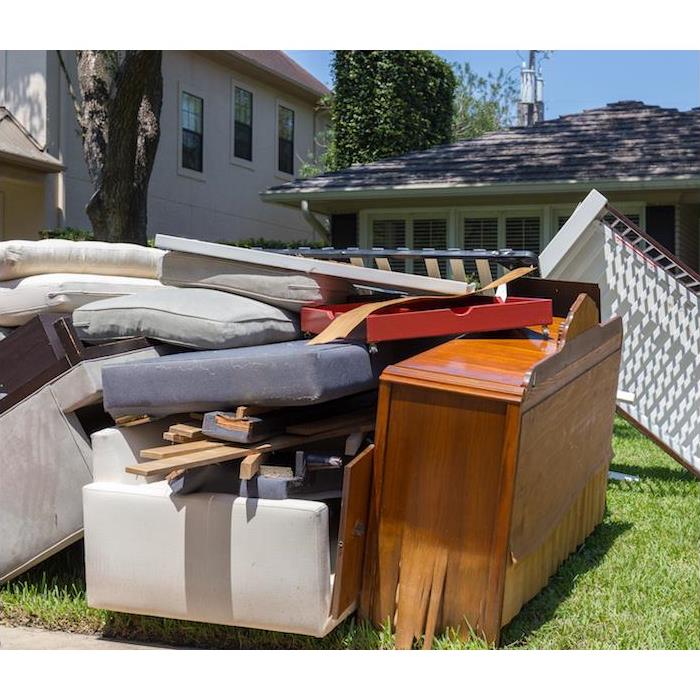 If you’re experiencing any water damage from flooding, SERVPRO of Ames is available 24/7 to assist you with any repairs.
If you’re experiencing any water damage from flooding, SERVPRO of Ames is available 24/7 to assist you with any repairs.
If your home in Ames has been impacted by a flood, it is common to feel like you are ready to get started on recovering right away.
While getting started as quickly as possible is a smart decision, it is also vital that you make your own safety a priority and ensure you are not putting yourself in harm’s way or causing any further damage to your home. Acting quickly following a flood is possible as long as you are also taking the right steps to keep yourself and your household safe.
Returning Home in the Aftermath of a Flood
Avoid further safety hazards. The first thing to remember after a flood is to never return home until officials have deemed it safe. There are many dangers such as electrical currents, contaminated water and other hidden hazards that might be present. If you can do so safely, turn off the electricity main to the house, but never do so if it is in standing water.
Air out the home. If there is no inclement weather on the horizon, opening doors and windows up will help rid the home of stale and hazardous air. Mold growth will have likely already started if surfaces are wet, but increasing air circulation can prevent it from becoming out of hand. If it has been a few days since you have been able to enter the house, entering to begin the airing out process and then leaving to let the toxic air escape is advised.
Document the damages. While it can be tempting to start the cleanup process right away, it is recommended to take pictures of the damages and impacted objects before touching anything for flood insurance purposes. While many floods are not covered under general homeowner’s policies, if you do have coverage, having documentation of the damages can help you get the most out of your claim.
Contact your restoration and insurance companies right away. It is always recommended to let your insurance company know about flood damage as soon as possible to see what coverage options are available to you. Next, you should reach out to your preferred restoration company to get the process started right away. The longer flood and water damage sits untreated, the more damage it can do to the structure of your home.
If your home has been damaged in a flood, we are here for you. You can contact us 24⁄7 to receive a quick response and set the restoration process in motion. We service all of Story County and Boone County.
Avoid Water Damage From Appliances
2/9/2020 (Permalink)
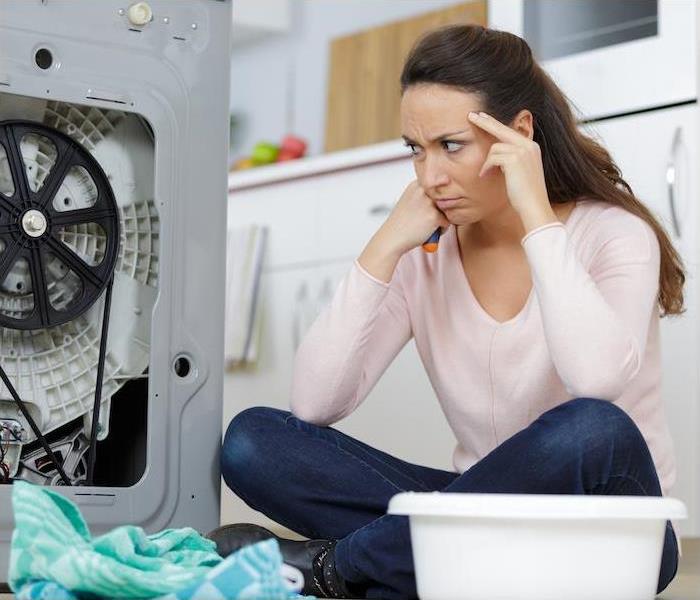 If your home experiences any flooding or another water issue, SERVPRO of Ames is here to dry, clean and repair any damage.
If your home experiences any flooding or another water issue, SERVPRO of Ames is here to dry, clean and repair any damage.
While flooding is often assumed as the main cause of water damage, one of the most common culprits is actually appliances in the household. Fortunately, being aware of this as a homeowner can help with prevention.
By knowing what appliances are known to commonly cause water damage, homeowners can check for the key signs of risk in order to practice prevention and avoid the woes of water damages.
Appliances That Are Common Causes of Water DamageHot Water Heater
Hot water heaters are one of the leading culprits of water damage from appliances. Typically, they will be designed to last between 10 and 15 years, but leaks can start much earlier due to factors of construction materials, installation and premature corrosion.
Refrigerator
The ice maker on the refrigerator typically has water lines made of a bendable plastic, which can develop micro-tears over time. Due to the fact that refrigerators are not moved frequently, this can lead to water damage that can accumulate and cause significant issues. Moving your refrigerator away from the wall to check the hoses can go a long way in preventing this.
Dishwasher
Dishwashers typically do not get moved away from their cubby until it is time for replacement, and this often causes homeowners to discover hidden water damage in the process. Soft floors or discoloration can be an indicator, but it is important to do regular checks. It is also important to not exceed the manufacturer’s lifetime estimate for the dishwasher—water damage from older models is often exempt from insurance coverage.
Washing Machine
The water used by washing machines is significant, and the hoses connected to them have been known to fail and cause hidden leaks. It is important to check the hoses every 30 days, with a replacement every five years being the recommended time frame.
Air Conditioner
Air conditioning units create condensation as part of their normal operations, and this moisture will generally be drained away through the mechanisms in place to do so. However, issues with drain lines and leaks can lead to water damage instead. Regular maintenance of your unit and check on it frequently is the best prevention tactics to make sure all is operating well.
If your home has been impacted by water damage or you’d like to put a plan in place in case it happens to you, contact us to learn how we can help.
An Overview of Flood Damage
2/9/2020 (Permalink)
Water damage is always an inconvenience, but flood damages have their own considerations. With the many types of floods and the multiple ways that water can infiltrate the home, the severity of the damage is often surprising.
The impact of floods continues to rise in every part of the world, making it vital that homeowners take the time to understand the issues floods can lead to and how they should react.
Ways Flooding Can Damage HomesFoundational Damage. When a flood saturates the soil the home’s foundation is built on, parts of it can become raised. This can lead to cracks in the foundation, as well as sealing problems with door and window frames throughout the home.
Drywall Damage and Mold. The waterlogged drywall can become weak and begin to fall apart, but that is not the only issue. Drywall can allow mold to grow underneath it, infiltrating the structure of the home and requiring replacement of any ceilings or walls that were affected.
Insulation Saturation. While certain types of insulation do not absorb moisture, most types can easily become soaked through and require replacement due to the high rate of mold growth they can cause.
Temporary Frame Swelling. The good news about a house’s frame is that it is typically constructed of solid lumber, meaning any swelling will be temporary. While mold precautions should certainly be taken to prevent an outbreak, most frames will remain structurally sound after a flood.
Appliance Ruining. Ovens and refrigerators contain insulation and almost always require replacement following a flood. That being said, other types may be able to be salvaged, but they must be inspected by an expert to be certified as safe before using.
Furniture Damage. Upholstered furniture can absorb a surprising amount of water, making it susceptible to water damage and mold growth. Furniture made of wood, glass pieces, and other miscellaneous materials should be cleaned thoroughly but should be OK for use.
If your home has been affected by a flood, we’ll be here to help you! Give us a call 24⁄7 to learn about our certified flood restoration process.
Flooding Can Happen Anywhere
5/24/2019 (Permalink)
According to the National Weather Service, "Approximately seventy-five percent of all Presidential disaster declarations are associated with flooding." When catastrophic water damage happens to you, SERVPRO can help. We can help you prepare ahead of time with an Emergency Ready Profile (ERP), or respond to any size disaster to begin cleanup and restoration to get you back in business as soon as possible.-Restoration Newsline
Spring Showers Bring Flowers (and Floods)
4/29/2019 (Permalink)
We are all relieved to see cold weather leave for awhile, but, be careful what you wish for when the potential for heavy rain sneaks in the weather forecast. The timeline below is to provide you with helpful information about what happens when water invades your home or business.
Water Damage Timeline
Within Minutes
Water quickly spreads throughout your property, saturating everything in its path.
Water is absorbed into walls, floors, upholstery, and belongings.
Furniture finishes may bleed, causing permanent staining on carpets.
Photographs, books, and other paper goods start to swell and warp.
Hours 1 - 24:
Drywall begins to swell and break down.
Metal surfaces begin to tarnish.
Furniture begins to swell and crack.
Dyes and inks from cloth and paper goods spread and stain.
A musty odor appears.
48 Hours to 1 Week:
Mold and mildew may grow and spread.
Doors, windows, and studs swell and warp.
Metal begins to rust and corrode.
Furniture warps and shows signs of mold.
Paint begins to blister.
Wood flooring swells and warps.
Serious biohazard contamination is possible.
More Than 1 Week:
Restoration time and cost increase dramatically; replacing contaminated materials and structural rebuilding may be extensive.
Structural safety, mold growth, and biohazard contaminants pose serious risks to occupants.
Flooded Basement in Story City Home
1/8/2019 (Permalink)
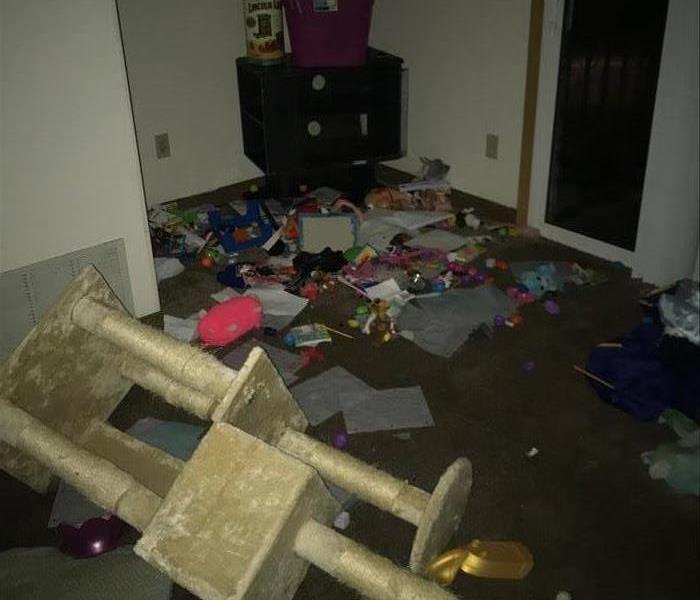 This flooded living room was caused by frozen pipes breaking due to cold weather.
This flooded living room was caused by frozen pipes breaking due to cold weather.
Ames Iowa Frozen Pipes Water Damage
The recent cold weather is causing an influx of problems and damage with freezing pipes. The frozen pipes break and cause water damage resulting in mold which causes health effects.
Pictured here is a recent example of this winter's damage. The SERVPRO team of certified technicians were called in to cleanup the aftermath. The living room of house was restored and brought back to life by our crew. The owner was very pleased with our services and referred to our trained team of professionals as "part of the family".
SERVPRO of Ames is the one stop shop for all your home damage needs. Here at SERVPRO we pride ourselves in being first responders to any and all home cleanup and restoration. Our certified technicians provide exceptional unmatched service.




 24/7 Emergency Service
24/7 Emergency Service







